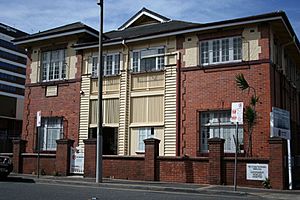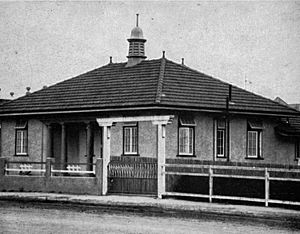Fortitude Valley Child Health Centre facts for kids
Quick facts for kids Fortitude Valley Child Health Centre |
|
|---|---|

Fortitude Valley Child Health Centre, 2010
|
|
| Location | 112 Alfred Street, Fortitude Valley, Queensland, Australia |
| Design period | 1919–1930s (interwar period) |
| Architect | Cecil James Virgo |
| Architectural style(s) | Arts & Crafts |
| Official name: Fortitude Valley Child Health Centre, Fortitude Valley Baby Clinic & Nurse Training Centre | |
| Type | state heritage (built) |
| Designated | 12 August 2011 |
| Reference no. | 602788 |
| Significant period | 1923–present |
| Lua error in Module:Location_map at line 420: attempt to index field 'wikibase' (a nil value). | |
The Fortitude Valley Child Health Centre is a special building in Fortitude Valley, Australia. It's located at 112 Alfred Street. This building is important because it has been helping mothers and babies for a very long time. It was designed by Cecil James Virgo and is also known as the Fortitude Valley Baby Clinic & Nurse Training Centre. It was added to the Queensland Heritage Register on 12 August 2011, meaning it's a protected historical site.
Contents
History of the Health Centre
Why the Centre Was Built
The Fortitude Valley Child Health Centre opened in 1923. It was built as a baby clinic and a place to train nurses who cared for mothers and babies. It also served as the main office for all baby clinics across Queensland. This centre was the first building specifically made for training nurses in maternal and child welfare in Queensland. This happened after a new law, the Maternity Act 1922, was introduced. This law was part of a big effort around the world to make mothers and babies healthier.
At the start of the 1900s, many babies in Queensland did not survive. Dr. Alfred Jefferis Turner, a doctor at the Brisbane Children's Hospital, worked hard to reduce these deaths. He helped introduce a medicine called diphtheria antitoxin in 1894. Dr. Turner also taught mothers about clean ways to prepare food, especially for babies who weren't breastfed. This was important because diarrhoea was a major cause of infant deaths.
Early Efforts to Help Babies
Around the world, people were trying to lower infant deaths by teaching mothers. In 1905, England and Germany started "Schools for Mothers." In New Zealand, Dr. Truby King founded the Royal Society for the Health of Women in 1907. He focused on encouraging breastfeeding and training nurses in mother and baby care.
In 1908, Dr. Turner opened the first baby clinic in Brisbane. He saw many babies for free, but this clinic closed due to lack of money. Groups like the Woman's Christian Temperance Union and the National Council of Women of Queensland kept asking for more baby clinics. In 1917, the government announced plans for four clinics in Queensland. At that time, New South Wales had 11 clinics and Victoria had one.
The first Queensland Government baby clinic opened in a rented house in Brunswick Street, Fortitude Valley, on 8 March 1918. It was managed by Matron Florence Chatfield. Fortitude Valley was a busy area with many homes and shops. Soon after, three more clinics opened in Woolloongabba, Spring Hill, and West End.
Funding and New Laws
In 1918, a conference in Brisbane showed how to care for babies. Charles Edward Chuter, a government officer, helped fund mother and baby facilities. He used money from the Golden Casket lottery, which gave its profits to a fund for mothers, child welfare, and hospitals. The government took over the lottery in 1920.
The money from the Golden Casket helped bring in the Maternity Act 1922. This law was a big step for health services for women and children in Queensland. It allowed for new maternity hospitals and baby clinics across the state. The law aimed to reduce deaths of mothers and babies, increase birth rates, encourage people to settle in outback areas, and teach mothers how to care for children.
Building the Centre
In 1923, a newspaper announced that a new mother and child welfare clinic and nurse training school would be built in Fortitude Valley. Charles Chuter had planned for the clinic to have a lecture room, clinic equipment, and a ward with three beds for mothers. It would be the main office for all Maternal and Child Welfare Clinics in Queensland.
The building was designed by Cecil James Virgo from the Queensland Department of Public Works. He designed many beautiful public buildings during that time. His designs often looked classic but were built in modern styles. They were made to feel like homes and were built with strong, lasting materials.
The government bought land on Alfred Street for £850. The location was good because it was near shops and public transport, close to the Brunswick Street railway station. An old house on the site was used as a clinic, and another was sold. Construction of the new brick building started in 1923. It cost £5,000 and was finished in early 1924.
Inside the New Centre
The new Fortitude Valley Baby Clinic and Nurse Training Centre had wooden verandahs on both levels at the front and back. The ground floor had the clinic, with a waiting room, doctor's room, and treatment rooms. It also had living areas for nurses in training, including a day room, bathroom, and kitchen. The first floor had the training centre with a large lecture room and a ward for three mothers and their babies. It also had the Superintendent Nurse's bedroom and a sitting room. The basement was used for storage and laundry.
The floors were originally wood, but in 1925, linoleum was added because the wooden floors were too slippery for mothers and children.
Nurse Training and Expansion
The first nurses at the centre were trained elsewhere. Nurse Barron, trained in New Zealand, became the head of the centre. The first four-month training course for Queensland nurses started in late 1924. It trained eight nurses, who then went on to run new baby clinics in other towns. Many new clinics were built across the state between 1923 and 1930.
By 1925-26, the Fortitude Valley Child Health Centre had the most visitors and newborn visits compared to other clinics. It was the main office for Queensland's baby clinics until about 1942. Dr. Turner and Nurse Barron traveled the state, teaching about good infant care.
Changes and Growth
By 1927, more patients were coming to the clinic, and there wasn't enough space. The front verandah was enclosed to create more room. The back verandah was also enclosed to make a bedroom for the Superintendent Nurse and a dining room for staff. In 1928, part of the ground floor verandah was enclosed to give mothers and babies more privacy.
In 1929, the centre started offering ante-natal care (health care before birth). During the 1930s, the clinic was often very busy. A law in 1932 made it required for all births to be reported quickly to the nearest clinic.
In 1938, a large two-storey extension was added to the building on the south-western side. This added many new rooms and more space. The extension was designed to match the original building. This new part was used as a Mothercraft home, where mothers and their babies could stay.
During World War II, the clinic helped families who had to move from dangerous areas. Because of petrol shortages, more clinics were opened in every suburb, reaching 38 by 1942. The main office, training school, and residential services later moved to other locations, like the Lady Lamington Hospital site.
By 1950, the infant mortality rate had dropped significantly. New clinics opened, and older ones were expanded. By 1975, Queensland had the lowest infant mortality rate ever recorded.
Since the 1970s, the Fortitude Valley Child Health Centre has continued to operate as a baby clinic. Some administrative staff moved to a new building in 1975. In 1997, the Oral Health Service of Queensland Health moved into the building. Today, Community Child Health Services still uses the ground floor. The building was sold in 2016, and there are plans to change it into offices and apartments.
Building Description
The Fortitude Valley Child Health Centre is a two-storey brick building with a partial basement. It faces north-west towards Alfred Street and is set back from the road behind a brick fence. The building is designed in the Arts and Crafts style.
The roof is hipped and made of corrugated asbestos cement sheets. The outside walls are red brick. The windows are usually timber casements with eight panes and smaller windows above them. Many windows have steel mesh security panels. A plaque on the front of the building says "BABY CLINIC TRAINING CENTRE, ERECTED 1923 AD."
The rear verandah, on both levels, is enclosed with painted wooden boards and different types of windows. A timber fire escape staircase runs down the back of the building from the upper level.
You enter the building through a central verandah at the front. This verandah has simple painted timber railings. It is partly enclosed with timber windows and fixed glass. The ground floor still has an old steel security gate and a wooden bench.
Inside, the rooms are mostly as they were in 1940. There's a large central area that serves as a reception on the ground floor and a waiting area upstairs. This central space leads to rooms on three sides. The walls are made of plaster on steel rods. Rooms on the enclosed verandahs have walls lined with vertical wooden boards.
The ceilings in the main part of the building are flat with timber strips in a simple pattern. The building still has its original internal walls, doors, and window frames. Most doors have three panels and are tall, keeping their original handles. The staircase is made of beautiful silky oak wood.
The floors are covered with linoleum or carpet, but the original wooden floors might still be underneath. The central areas on both levels have chair rails. The enclosed part of the front verandah on the ground floor contains many old items related to baby clinic functions. These include baby-weighing scales, metal cots, and photos of nurses. The basement also holds some original doors that were removed from the upper levels.
Heritage Listing
The Fortitude Valley Child Health Centre was added to the Queensland Heritage Register on 12 August 2011. This means it's recognized as an important historical place for several reasons:
- Showing Queensland's History: This centre is important because it shows how health and social policies developed in Queensland. It was the first training centre for nurses who cared for mothers and children. It was also the main office for all other baby clinics in the state. It helped teach mothers about baby care and hygiene, which was a big effort in the early 1900s to reduce infant deaths.
- Rare and Special: This centre is one of only two original child health clinics from a group of 13 built between 1923 and 1930 that are still in use today. It is very well preserved and has been continuously used as a child health centre since it opened.
- Good Example of its Type: The Fortitude Valley Child Health Centre is a great example of a building made specifically for maternal and child welfare. It has all the important features, like a large waiting area, doctor's room, treatment room, and nurse accommodation. It also includes a nurse training centre with a lecture room, and rooms for mothers and babies. It's a good example of a well-designed government building from the time, built with good materials and a home-like feel.


